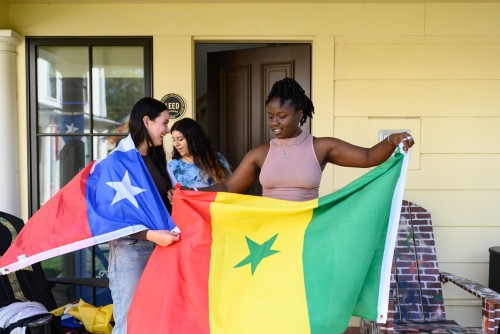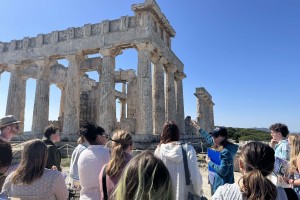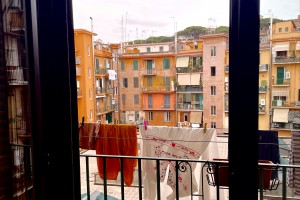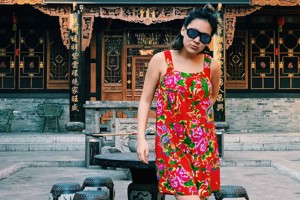We come to Gambier, Ohio, from every region of the country and corner of the globe to better understand our place in the world. Together, we explore questions that transcend languages, cultures and personal histories. We apply our learning to solve real-world problems, building on our insights with internships, independent research and off-campus study programs.
Go There
We offer more than 250 immersive study abroad programs across 50+ countries. We also sponsor signature programs in England and Italy, and support a number of learning opportunities throughout the U.S.
Primary Sources
Part of the excitement of studying abroad is exploring the world beyond Gambier — and coming back with new knowledge and experience. Read about students' adventures around the world.
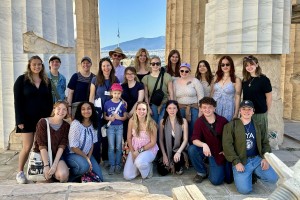
Learning on an Epic Scale
Students enrolled in two travel-embedded courses experienced ancient temples and giant tortoises firsthand in Greece and the Galápagos Islands over spring break.
-

Missing Pieces
First Person: Student Life at KenyonA trip to Greece as part of a travel-embedded course provided a valuable window into the plundering of ancient sites — and a resolution for one student to be part of the solution.
DateCategories -

When in Rome
First Person: Student Life at KenyonBefore studying abroad, I told myself to just say “yes” whenever a new opportunity presented itself.
DateCategories -

From Gambier to Accra to Beijing: My Year Abroad
First Person: Student Life at KenyonJodi Ann Wang ’20 looks back on her studies abroad in Beijing, China, as she prepares to return for her senior year at Kenyon.
DateCategories
A Community of Diverse Perspectives
Students from 53 countries bring their points of view to a multicultural community where all of us—students, faculty, and staff—learn from a diversity of experiences and perspectives.
Every year, nearly half of Kenyon’s junior class participates in an off-campus learning opportunity.
-
18the number of times Kenyon has been named a top producer of Fulbrights in the last 20 years.
-
47countries to which our graduates have been awarded Fulbright Fellowships since 2006-07.
-
9modern languages are taught at Kenyon: American Sign Language, Arabic, Chinese, French, German, Italian, Japanese, Russian and Spanish.
-
15countries are represented in Global Course Connections, an international alliance that connects courses from two colleges.
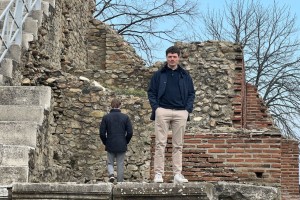
Kenyon Named a Top Peace Corps Producer
The College ranked No. 2 among small schools in producing volunteers for the government agency that promotes world peace and friendship.
A Global Curriculum
Arab World Through Literature and Film
Open to students interested in film, religion, history and more, this course explores the various cultures of the Arabic-speaking world through the lens of Arabic literature and cinema. By exploring multiple perspectives, discover the richness of this “othered” culture, as well as examine its similarities with your own.
Cultural Productions of the Borderlands
Chicana/o culture in the U.S. is a vast yet underrepresented field. This absence is symptomatic of a history of oppression that results in silencing the “other” America. This course, offered in both Spanish and English, will help you gain a deeper understanding of borderlands within the context of their colonial legacies
Illegal Antiquities
Who owns the Classical past? In this seminar we’ll discuss a range of ethical dilemmas presented by the practice of archaeology in the 21st century, including the looting of ancient sites; aspects of the international trade in art objects and antiquities; authenticity and forgery of ancient art; and more
Asian Music Ensemble
Kenyon is one of few colleges to offer Sundanese gamelan degung, a traditional Indonesian ensemble. You’ll be introduced to basic and advanced instrumental techniques and receive coaching in musicianship and ensemble skills, culminating in public performance. No musical experience required!
Global Partnerships
Writing Beyond Borders
Kenyon science faculty, the Kenyon Science and Nature Writing Initiative and the Indian Institute of Technology Madras in Chennai, India, partner in annual workshops designed to hone the writing skills of India’s most talented science and engineering students and scholars.
Humanities Across Borders
Kenyon is one of just two American members of Humanities Across Borders, an international consortium of colleges and universities focused on Asia and Africa and committed to locally rooted, globally conscious higher education and educational justice.
Far and Wide
This photo was taken during a three-day expedition of the Atlas Mountains and Sahara Desert. To see as much of Morocco as possible, a friend and I joined a tour group that included three doctors from London, a Moroccoan French family from Marseilles, and two Hungarian mathematicians. The students I met abroad were eager to travel far and wide and form identities beyond deadlines and seminars — we were people first, students second.
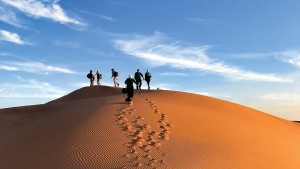
Photo by Eve Bromberg '19
